
Kjellbergska flickskolan ('Kjellberg Girls' School') was a Girls' School in Gothenburg, Sweden. It was active between 1835 and 1967. [1]

Kjellbergska flickskolan ('Kjellberg Girls' School') was a Girls' School in Gothenburg, Sweden. It was active between 1835 and 1967. [1]

The school was founded by a fund granted in the will of the wealthy merchant Jonas Kjellberg (1752–1832). Jonas Kjellberg was a merchant and trader who in 1808, formed an import and shipping company under the name Jonas Kjellberg & Co. Kjellberg died in 1832, and the school was inaugurated in 1835. [2] [3]
The stated purpose of the school was to provide education to make it possible for females to support themselves professionally. This separated the school from most other contemporary girls' schools, which had the purpose to educate their students as ideal wives and mothers, and it was thereby a part of the wave of a new type of girls' schools, which was established in Sweden in the mid 19th-century in response to a contemporary Swedish debate about women's education. Further more, Kjellbergska flickskolan accepted students free of charge, which made it possible to accept just the kind of student which answered to the description of a female who would be likely to need to support herself, normally from the middle classes. In this, the school followed the example of the Fruntimmersföreningens flickskola from 1815.
The most common occupation socially acceptable for a professional middle class woman in the 19th-century was that of a teacher or governess, and the school also functioned as an educational institution for female teachers. Between 1908 and 1932 (after a temporary experiment in 1884-86), it also offered teachers training courses to adult women. The graduates of these courses were, from 1910 onward, counted as equal to those from the Högre lärarinneseminariet in Stockholm.
The subjects were religion, French, German, English, Swedish, history, geography, writing, mathematics, music, drawing and handicrafts. The number of students counted 15 in the ages of 91-5 in 1835; 24 in 1842 and 92 in 1875. The school was managed by a female principal supervised by a board. It moved from one address to another until it was finally provided with a permanent home in 1870.
At the time of the introduction of compulsory elementary schools in Sweden in 1842, it was one of five schools in Sweden to provide academic secondary education to females: the others being Societetsskolan (1786) and Fruntimmersföreningens flickskola (1815) in Gothenburg, Askersunds flickskola (1812) in Askersund and Wallinska skolan (1831) in Stockholm.
In 1943, the school became a part of the communal school system in accordance with a new educational law, and in 1967, it was abolished in accordance with the new law against girls' schools.

The Royal Seminary, fully the Royal Advanced Female Teachers' Seminary, was a normal school in Stockholm, Sweden. It was active from 1861 until 1943. It was the first public institution of higher academic learning open to women in Sweden.
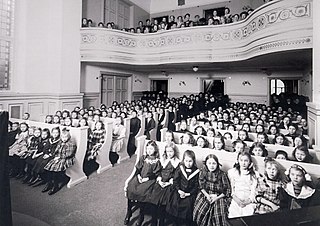
Wallinska skolan or Wallinska flickskolan, was a girls' school in Stockholm, Sweden. Active from 1831 to 1939, it was one of the first five schools in Sweden to offer serious academic education and secondary education to female students. In 1870, it became the first gymnasium for females in Sweden, and in 1874, it became the first girls' school that was permitted to administer the Studentexamen to females.
Societetsskolan i Göteborg för döttrar or simply Societetsskolan, was a Swedish girls' school managed by the congregation of the Moravian Church in Gothenburg from 1 November 1787 until 1857. It is referred to as the first girls' school in Sweden, because it was the first institution to provide serious academic secondary education to females.
Fruntimmerföreningens flickskola, was a Girls' School in Gothenburg in Sweden active between 1815 and 1938. At the time of the introduction of compulsory elementary schools in Sweden in 1842, it was one of five schools in Sweden to provide academic secondary education to females: the others being Societetsskolan (1786) and Kjellbergska flickskolan (1833) in Gothenburg, Askersunds flickskola (1812) in Askersund and Wallinska skolan (1831) in Stockholm.
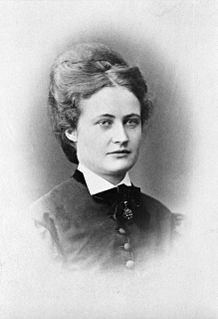
Anna Maria Carolina Sandström was a Swedish feminist, reform pedagogue and a pioneer within the educational system of her country. She is referred to as the leading reform pedagogue within female education in Sweden in the late 19th century.
Uppsala högre elementarläroverk för flickor or Högre Allmänna läroverket för flickor was a pioneering Swedish school and later college for females. Commonly referred to as Magdeburg, the school was located in Uppsala, Sweden and was active from 1865 until 1968.
The Flickskolekommittén 1866, was a Swedish governmental committee established by the Swedish Parliament, the Riksdag, in 1866 to examine organization of female education in Sweden and produce suggestions of reforms and recommendations on how the policy regarding education for women should be organized. This was the first governmental committee of its kind, and was to have a large impact upon the educational system as well as gender roles and policy regarding women's rights in general in Sweden.
Hedvig Amalia Aurora "Aurore" Storckenfeldt was a Swedish reform pedagogue. She founded the Storckenfeldtska skolan in Jönköping, and served as its principal in 1847–1891, during which time it was regarded as one of the best educational institutions for females in the nation. Storckenfeldt is regarded as an important member of the pioneers of girl's education in the mid 19th century Sweden, who reformed the education of girls by establishing girls' schools which offered proper academic education for females, in contrast to the earlier girl's pensions shallow education.
Askersunds flickskola, was a Swedish girls' school in Askersund, active from 1812 until 1906. It was the second school in Sweden to offer secondary education to female students. Formally, Askersunds flickskola was a branch of the Askersund secondary educational school for boys. The schools were formally referred to as Prins Oscars goss- och flickläroverk.

Maria Helena Stenkula was a Swedish reform pedagogue and pioneer on women's education. She was regarded as a local pioneer of women's education in Malmö, Sweden. She was the founder and manager of the Malmö High School for Girls from 1874 until 1899.
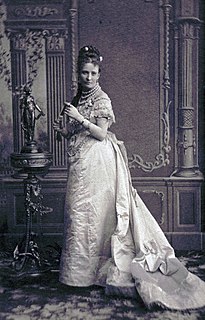
Events from the year 1874 in Sweden
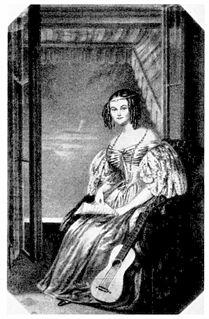
Events from the year 1835 in Sweden
Hilda Wilhelmina Josefina Caselli, or Casselli was a Swedish reform educator. She played an important role in the debate of educational issues and women's education in Sweden in the late 19th century. She served as principal of the Statens normalskola för flickor and vice principal of the Högre lärarinneseminariet, and became the founder of the regular national girls' school meetings, Flickskolemöte, in 1879.
The following is a timeline of the history of the municipality of Gothenburg, Sweden.
Eva Brag (1829–1913) was a Swedish journalist, writer and poet.
Anna Rönström (1847–1920), was a Swedish educator. She was a local pioneer of female education in Lund, and the founder of the secondary education school Högre Elementarskolan i Lund for girls, also customarily known as Rönströmska skolan .
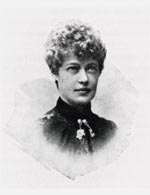
Alma Mathilda Åkermark was a Swedish editor, feminist, writer, journalist and women's rights activist. She was a co-founder of the radical feminist women's paper Framåt ('Forward'), and its editor during its entire publication. She wrote under the pseudonym Mark. She was active within the Gothenburg's Women's Association, and a leading figure within the most progressive and radical part of the Swedish and local women's rights movement, and was noted for her involvement in the Sedlighetsdebatten.
Helena Eldrup, was a Swedish educator. She was the first principal of the Kjellbergska flickskolan in Gothenburg from its foundation in 1835 until her death in 1872.

Therese Kamph (1836–1884), was a Swedish educator. She was the principal of the Kjellbergska flickskolan in Gothenburg from 1872 until her death in 1884. She is credited with having developed the school to one of the foremost institutions for secondary education for women in Sweden.
Gunhild Kyle was a Swedish historian. She was Sweden's first professor of women's history at the University of Gothenburg.